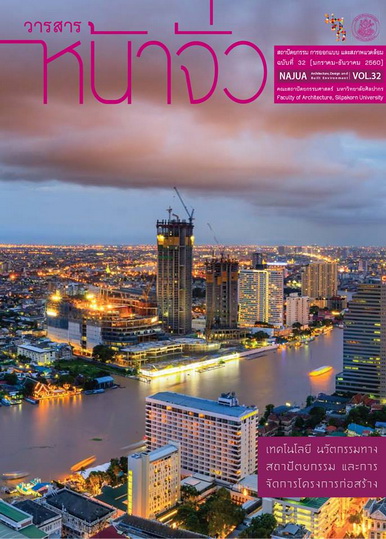Management of Cultural Landscapes as the Means for Sustainability and Community Resilience Building
Keywords:
cultural landscape, community resilience, sustainability, ภูมิทัศน์วัฒนธรรม, ความยืดหยุ่นของชุมชน, ความยั่งยืนAbstract
This study aims at illustrating complex processes of cultural landscape transformation in a parallel with holistic pictures of community resilience to the impacts from global changes, and the statement of sustainable development. Three communities in Asian countries that were chosen to be the case studies include Mukugawa, an upland Village in Japan, Khiriwong, a mountain village in the Southern part of Thailand, and Diura, a small fisherman village in the Batanes Islands, the Philippines.
The three case studies show that management of cultural landscapes has been based on sets of local knowledge. Cultural landscapes are not static. They have been transformed through times. Affected by changes in local, national, regional and global level, communities have played important roles in managing spatial structures and other resources. Grounded on cultural and social capital, various kinds of community groups have worked for adapting local knowledge, combined with other set of knowledge, and then produced new sets of knowledge.
In order to build effective collaborative management, the bonding and bridging among groups have been created, while the linkage between local groups and outside organizations, especially governmental and non-profit organizations have been properly formed. According to the three case studies, it can be stated that inventive practices in managing cultural landscapes provide benefits to community resilience building. Meanwhile, proper management of change ensures economic, socio-cultural, and ecological balance that leads to statement of sustainability.
การจัดการภูมิทัศน์วัฒนธรรมในฐานะเครื่องมือในการสร้างความยั่งยืนและความยืดหยุ่นต่อการเปลี่ยนแปลงของชุมชน
วิมลรัตน์ อิสระธรรมนูญ
ภาควิชาสถาปัตยกรรมศาสตร์ คณะสถาปัตยกรรมศาสตร์ จุฬาลงกรณ์มหาวิทยาลัย
การศึกษานี้ต้องการที่จะทำความเข้าใจถึงกระบวนการ การแปรเปลี่ยนของภูมิทัศน์วัฒนธรรม (cultural landscape transformation) โดยพิจารณาประกอบกับความเข้าใจในเรื่อง ความยืดหยุ่นของชุมชน (community resilience) ต่อผลกระทบจากการเปลี่ยนแปลงของโลก กับ การพัฒนาที่ยั่งยืน (sustainable development) ชุมชน 3 แห่งจากประเทศในทวีปเอเชีย 3 ประเทศ ที่ได้รับเลือกมาเป็นกรณีศึกษาประกอบด้วย มุกุกะวะ หมู่บ้านในพื้นที่สูงในประเทศญี่ปุ่น คีรีวง หมู่บ้านในภูเขาทางภาคใต้ของประเทศไทย และ ดูระ หมู่บ้านชาวประมงขนาดเล็กแห่งหนึ่งในหมู่เกาะบาตาเนส ประเทศฟิลิปปินส์
กรณีศึกษาทั้งสามแห่งแสดงให้เห็นว่า การจัดการภูมิทัศน์วัฒนธรรมอยู่บนฐานของชุดความรู้ในท้องถิ่น ภูมิทัศน์วัฒนธรรมเป็นสิ่งที่ไม่อยู่นิ่ง มีการเปลี่ยนแปลงอยู่เสมอ จากผลกระทบอันเนื่องมาจากความเปลี่ยนแปลงในระดับต่างๆ ทั้งในระดับท้องถิ่น ระดับชาติ ระดับภูมิภาค และระดับโลก ส่งผลให้ชุมชนได้มีบทบาทสำคัญในการจัดการโครงสร้างทางกายภาพในลักษณะของการใช้พื้นที่ รวมไปถึงการจัดการทรัพยากรด้านต่างๆ ในการนี้ กลุ่มองค์กรในชุมชนได้มีการปรับใช้ความรู้ในท้องถิ่นผสมผสานเข้ากับความรู้จากภายนอก จากนั้นจึงมีการสร้างชุดความรู้ขึ้นใหม่ โดยอาศัยรากฐานจากทรัพยากรทางวัฒนธรรมและทรัพยากรทางสังคม
ในการที่จะสร้างการจัดการพื้นที่อย่างมีประสิทธิภาพนั้น จำเป็นจะต้องมีการเชื่อมโยงการทำงานระหว่างกลุ่มองค์กร ตลอดจนเชื่อมต่อกลุ่มองค์กรในชุมชนกับองค์กรภายนอก โดยเฉพาะหน่วยงานภาครัฐและองค์กรไม่แสวงหาผลกำไร กรณีศึกษาทั้งสามแห่งชี้ให้เห็นว่า การจัดการภูมิทัศน์วัฒนธรรมอย่างสร้างสรรค์นั้น ก่อให้เกิดผลดีกับการสร้างความยืดหยุ่นของชุมชนต่อการฟื้นตัว และการปรับตัวจากความเปลี่ยนแปลงต่างๆ ที่เกิดขึ้น ในขณะที่การจัดการความเปลี่ยนแปลงอย่างเหมาะสม ช่วยให้เกิดความมั่นใจว่าจะเกิดความสมดุลทางเศรษฐกิจ สังคม-วัฒนธรรม และระบบนิเวศ อันจะนำไปสู่สภาวะแห่งความยั่งยืนต่อไป





